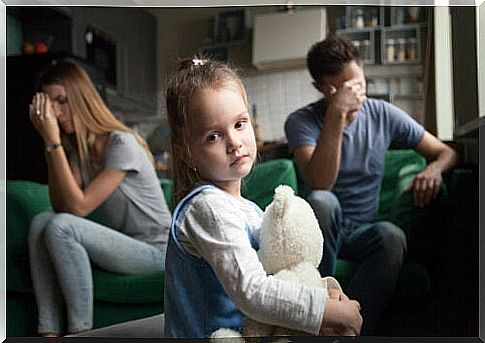10 Family Interaction Patterns That Can Be Harmful

The way in which the members of a family communicate with each other is a necessary condition for maintaining harmony in the family. Certain ways of interacting shapes however interaction patterns which may be detrimental to the family.
Family psychology has studied these dysfunctional bonds and how families unconsciously adapt to them. Although this is a rather complicated topic, we will try to explain how these inappropriate interaction patterns manifest themselves within the family. This way you can recognize them in time and act accordingly.
Dysfunctional interaction patterns within the family
Psychologists (Spanish link) define family relationships by the number of relatives. In general, in models with three or more members, harmful family interaction patterns may exist. In this article, we therefore describe each of those patterns.
1. Paradoxical communication
In paradoxical behavior , the messages communicated are incongruous and ambiguous.

As a result , the child is caught in a double knot, in which the same parent appears and displays a protective attitude, but at the same time devalues it. For example: “You have to do it yourself, but I’ll do it because you can’t. ”
2. Disqualification and Denial
Overruling or minimizing a family member’s decisions involves developing a disqualifying pattern of interaction. This is a kind of pathological communication, which include the use of annoying nicknames or inappropriate qualifications means to the other belittle.
This kind of interaction thus creates an atmosphere of uncertainty to which the family unconsciously adapts. And at the same time it creates a dysfunction in the bond that is detrimental to everyone.
3. Interaction patterns: mumbling, silences, and laughing (not related to humor)
By talking too much, not talking, or laughing all the time for no reason, you often avoid facing serious problems. Silences are also sometimes used as methods of punishing or controlling someone, something commonly known as ‘freezing someone’.
These patterns of interaction create environments in which difficulties are never overcome because decision makers are constantly moving out of the way.
4. Projecting by the family
When children are treated as commodities belonging to their parents, they lose the ability to build their own self.
In these cases, the child’s effort is focused on being the child his parents want and not the independent and critical person he should be.
5. Dependence
If the requirements and needs are satisfied compulsive child, make the parents then difficult for the child to build an identity.
If he can’t even express his preferences and feelings because the parents assume they already know them, the child loses the ability to recognize and express them.
6. Lack of Attention and Disconnection
Contrary to the above, systematic neglect produces feelings of helplessness and defenselessness.
7. Alliances and Coalitions
When several members of the family come together to create conflict and confront other members, the results are detrimental to all.
Behaviors such as denial, triangular thinking, and scapegoat thinking appear in these family interaction patterns. The child then sets aside his autonomy to promote the stability of the parents.

8. Complementarity of Interaction Patterns within the Family
This type of interaction implies the acceptance of two different roles in the family: one of dominance and the other of submission. Simply put, one member gives orders and the other member obeys.
The problem with these relationships is, among other things, that they become rigid and do not give the one who obeys the opportunity to grow and develop.
9. Symmetry
Symmetrical interaction presupposes equality between the parties. It can also promote variety in decision-making based on negotiation.
In pairs, symmetrical ascension problems can arise, with both individuals provoking each other to be “above the other.” This situation usually leads to permanent discussions within the family and problems with violence.
10. Mask or keep up appearances
Experts call this pseudo-mutuality and pseudo-hostility . They are interaction patterns in which family members seem to care about or hate each other, respectively.
None of this is true , however , and in either case it hides a pathological interaction between family members that creates confusion and an unstable environment.
In these cases, it is the children who suffer the most, because they do not find in their environment the emotional peace they need to develop their personality.
How to intervene in dysfunctional interaction patterns within the family?
To ensure a healthy family system, we must avoid these harmful interaction patterns within the family. They can be harmful to any member of a family.
Finding them is the first step, but after that it is important to seek the help of a family therapist to overcome them. Remember that family relationships (Spanish link) are the result of several complex factors. Every person involved has a special and unique story.









